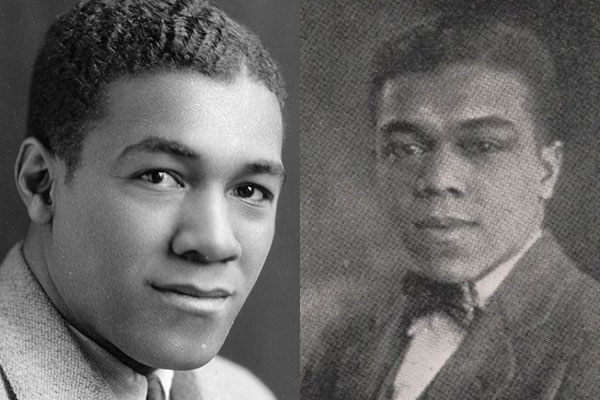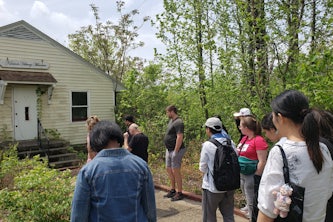The Knox Brothers: Blackness, Brotherhood and Scientific Achievement at the Turn of the 20th Century
Sharniece Holland, MEMS lecturer, co-authored the profile on the historic Black engineers

The Equity, Diversity and Inclusion Committee for The Minerals, Metals & Materials Society (TMS) was granted the opportunity to create a Black History Month spotlight in the February 2022 issue of the TMS’ member journal JOM.
The committee decided to highlight outstanding Black researchers in STEM because we wanted to bring awareness with this special issue. My co-author, Jonathan D. Madison, and I decided to write about the Knox Brothers because we realized that, like the Black mathematicians who worked at NASA, the Black scientists involved in the Manhattan Project have not been acknowledged. The Knox Brothers have an extraordinary history and I’m honored to bring recognition to them this Black History Month.
With a master craftsman as a grandfather, a best selling author for a grandaunt; and a father who earned the highest score on a civil service exam with little to no formal education; the Knox brothers’ academic success demonstrates a commonality still present today. While not a certainty, educational and professional success can often be correlated to a precedent of the same among the forebearers in one’s family. However, for Lawrence and William Knox, this is where any and all similarities to others end. The Knox brothers (William, Lawrence and a third named Clinton) acquired three bachelor’s degrees, three master’s degrees and three doctoral degrees from some of the United States’ most lauded and prestigious institutions of higher learning, thereby composing 7% of all African Americans to ever receive a Ph.D. in chemistry up to that point. This grand accomplishment even more remarkable since all this occurred prior to 1940 and their grandfather was, in fact, born into slavery.
William and Lawrence Knox were two of five children born to William Jacob and Estella Knox. These brothers would both go on to receive their doctorates in chemical engineering and organic chemistry from the Massachusetts Institute of Technology (MIT) and Harvard, respectively. Their brother, Clinton E. Knox would also go on to earn his Ph.D. from Harvard in European History. Collectively, their nine degrees (bachelors, masters and doctoral) were granted by Williams College, Bates College, Brown University, Stanford University, Harvard and MIT; a rare feat for any three brothers to accomplish by today’s standards and an even rarer task for three African American men to accomplish between the years of 1925 and 1940.
Professionally, both William and Lawrence contributed to their fields through both teaching and research. From 1929 to 1941, William taught general, analytical, organic and physical chemistry at four of the most prestigious of Historically Black Colleges and Universities (HBCUs); Johnson C. Smith University in Charlotte, North Carolina; Howard University in Washington D.C.; North Carolina Agricultural and Technical College in Greensboro, North Carolina; and Talladega College in Talladega, Alabama. Furthermore, at Talladega, William would go on to become the chair of the Chemistry Department. With limited options for educated African Americans in their era, Lawrence would pursue a similar path. Between 1928 and 1944, Lawrence taught chemistry at Morehouse College in Atlanta Georgia; North Carolina Agricultural and Technical College in Greensboro, North Carolina; and the North Carolina College for Negroes in Durham, North Caroloina
However, like many of their day, World War II would drastically impact the work, livelihood and professional focus of both William and Lawrence for years to come. In 1943 and 1944 respectively, William and Lawrence would both go on to join the research efforts of the Manhattan Project at Columbia University. While there, William bore the distinction of being the only African American to serve as a supervisor and did so for an all-white corrosion research group, which would make a particularly significant contribution by using gaseous diffusion to improve the isolation of uranium isotopes needed for the atomic bomb. Alternatively, Lawrence’s research in quinine would provide the framework for studying radiation and the effects of atomic reactions.
Later in life, William and Lawrence would both go on to further distinguish themselves with extremely well-decorated research careers beyond their time in Columbia University’s Division of War Research for the Manhattan Project. In fact, Lawrence would go on to work for three separate industrial laboratories in the U.S. and Mexico – Nopco Chemists, Hickrill Chemical Research Foundation and Laboratorios Syntex – and be granted four U.S. patents in just three years while working for Nopco. Later, he would co-author at least 10 papers and receive 40 patents related to steroid chemistry between the years of 1960 to 1965 while working at Laboratorios Syntex.
Similarly, following his time on the Manhattan Project, William would go on to become the second African American to be hired as a research assistant at Eastman Kodak Company where he was granted 21 patents over a period of 25 years. William’s work centered on the use of surface coating surfactants to improve the robustness and quality of photo development. Nine of these patents originally granted to William are still renewed by Kodak today.
Beyond their professional achievements, both William and Lawrence displayed a consciousness for the challenges surrounding them and each responded in their own way. William sought to combat the social ills he witnessed and all too often personally experienced. William, who experienced overt and volatile housing discrimination at multiple points in his life, became an active and vocal member of his local chapter of the National Association for the Advancement of Colored People (NAACP) and also became a founding member of the Urban League of Rochester in New York.
Lawrence’s contributions were less motivated by civil rights and social injustice and focused more on mentoring to help develop the next generation of scientists and researchers. During Lawrence’s time at Hickrill Chemical Research Foundation, he mentored and trained at least two local teenage interns who would both go on to significant scientific impact, Maitland Jones, Jr. and Caleb Finch. Jones and Finch both recalled the training and amazing patience Lawrence exercised with them as well as the profound impact he had on their relation to science. Jones would go on to become a professor of chemistry and dean of the faculty at Princeton University, and Finch who would go on to become a professor and chair of neurobiology at the University of Southern California.
Achievements within the laboratory as well as remarkable contributions beyond the bench were no rarity for these two distinguished scientific pioneers. However, it is remarkable to consider, had the United States not entered the war effort when it did and been so desperate to unlock the secrets of atomic energy, how many scientific breakthroughs in modern science, gaseous diffusion, corrosion and surface chemistry would we have missed out on from the likes of the Knox brothers? An even more humbling question to aks is, how many profound contributions have we been robbed of from others who had the poor misfortune of living in a time wherein the need for their contribution did not outweigh the ignorance and wanton poverty of ideals created and maintained by discrimination, racism and hatred? The life and contributions of the Knox brothers clearly shows that while brilliance is precious, having an environment where brilliance from all sources can be realized and appreciated is what paves the way for revolutionary scientific breakthroughs.




